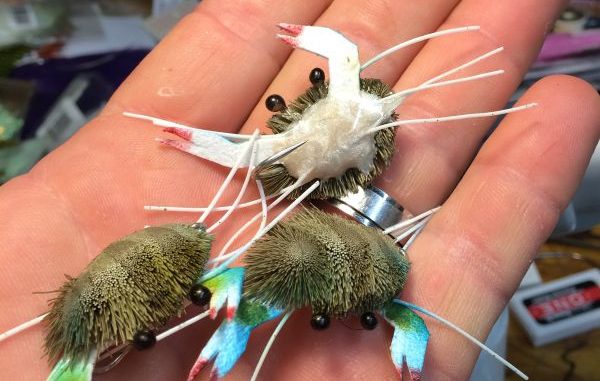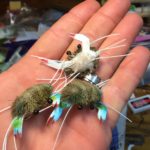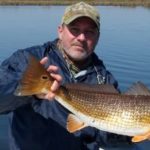
It was one of those idyllic October mornings in the Louisiana marsh. The air was brisk following the passage of a cool front the day before.
The feeling in the boat was electric — this was going to be a great day chasing the poisson rouge.
It took a couple hours for me and Cosmos to find some active fish. But when we did, we hit the jackpot. All over the flat, we could see reds rising and smacking something on the water’s surface.
After a couple of minutes, we figured out what the “hatch” was — tiny crabs.
Cosmos quickly tied on an olive deer hair diver that happened to be in his box. No sooner did it splash down when a 22-inch red came up and slammed it. Fight on!
Cosmos went on to catch nine reds on this fly before things shut down.
Topwater crabs for redfish. Sounds strange, doesn’t it? Not to Bill Laminack.
Laminack is one of the nation’s top saltwater fly tiers. The Panama City resident has created numerous patterns based on his on-the-water observations.
And his favorite crab fly is a float/swimming deer hair pattern called the Hill Tide Hero.
The main material for the HTH is spun deer hair that is trimmed and shaped to a crab body. The claws are made from Cohen’s Fly Suede; the legs are made of round silicone.
The hair allows the fly to float and drift with the current. Sort of like a dead drift for rainbow trout with a dry fly — except with a bigger fly and for more beastly fish.
Laminack also loves to work the Hill Tide Hero in passes for bull reds.
“We fish the strong outgoing tides around new and full moons,” he said. “We fish bridges and passes, casting the fly up current and dead-stick the fly. Take up slack and keep a tight line. The strike will be viscous.”
Capt. Tristan Daire is another advocate of lighter crabs.
Daire, a saltwater fly fishing guide and owner of Olde Town Fly Shop & Outfitters in Slidell, also uses the more-traditional weighted patterns at times.
“Each fishing scenario requires a different approach,” he explained. “Fishing open water and fringe areas or to elevated fish, I prefer lighter patterns and the long, slow continuous strip.
“Fishing pond systems or oyster-lined banks, I prefer heavier crabs.”
Daire retrieves weighted patterns in a manner typical of crabs scurrying on the bottom. He finds using a fly with upturned hooks necessary to avoid snagging.
Don’t ignore tackle considerations when casting crab flies, Daire noted.
“Crab flies have a lot of body and, as such, can be more difficult to cast when they are wet or with a stiffer breeze,” he explained. “I like to use shorter leaders with a 30-pound or thicker butt section to increase turnover on the cast.”
As for the particular types of crab flies, Daire likes Enrico Puglisi Crabs in blue and golden sand colors, traditional Merkin patterns, and various hand-tied patterns in olive and purple.
Sometimes the fly doesn’t have to look exactly like a crab; it just has to have the general silhouette and swimming characteristics.
A perfect example is the Crazy Charlie. Created in the late 1960s by Bahamas guide Charlie Smith for bonefish, many variations of the fly have emerged over the decades, including a few that more resemble fiddler crabs than the original did.
One of those variations is the LaFleur’s Charlie. Originated by Baton Rouge’s Mike LaFleur, it uses an estaz body, a craft fur wing and heavy dumbbell eyes tied on a No. 2 Mustad C71SS circle hook.
Here’s the technique Mike suggests for his fly: Cast it out in front of a cruising or tailing red, let it sit on the bottom, make a 6-inch strip that brings the fly off the bottom, and then pause and let it hit bottom again.
Repeat until outside the fish’s range.
When pulled off the bottom, this fly kicks up a little mud or sand. That’s why the weight of the dumbbell eyes is important. Mike uses the Wapsi brand that are rated X-SM (extra small) and weigh 1/50 ounce. This is quite a bit heavier than the bead chain eyes typically used on Crazy Charlies.
The first time I used a LaFleur’s Charlie in shallow water, it created a tiny mud cloud as I pulled it off the bottom: Immediately a red took notice and rushed to the fly.
On the second strip, the fish viciously attacked.
Since then, I never head to the marsh without some.
In addition to the LaFleur’s Charlie, the Merkin and the EP Crab, my redfish box also contains the Chernobyl Crab created by Tim Borski, and the Down and Dirty Crab originated by Gary Borger.
Laminack explained why variety is important.
“Experiment; match the hatch,” he said. “Your fly needs to approximate the color of the bait, and what the bait is doing when and where you are fishing.”.
Daire agreed, adding that now is the time to stock up on crustaceans.
“I always prefer to fish crab patterns throughout the late fall and winter, when baitfish are not as readily available to fish,” Daire said. “And in cold water, fishing the crabs to more-lethargic fish results in more fish to the boat.”




